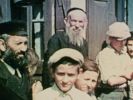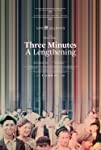Eye For Film >> Movies >> Three Minutes: A Lengthening (2021) Film Review
Three Minutes: A Lengthening
Reviewed by: Amber Wilkinson

What can you learn in three minutes? Documentarian Bianca Stigter shows us the answer is, an enormous amount if you take the time to really look. The three minutes in question is a segment of 16mm colour and black and white home movie, shot in the Polish town of Nasielsk in 1938 by David Kurtz, who was born there but had emigrated to America, returning briefly with his family as part of a European tour.
The frame is a hive of activity, with children crowding in, eager to see the new piece of equipment. Further in the background, are adults, some curious, others with a look of slight apprehension. There's a shop, a stream of worshippers exiting a synagogue - a bustling sense of life. What the faces we see don't know, is that many of them are about to be caught up in the Second World War in the most brutal of ways. All but 100 of the town's 3000 Jewish residents would go on to be murdered in the Holocaust.

For Kurtz's grandson Glenn, finding out as much as he could about the film became a passion project and Stigter firmly picks up the baton, using and expanding on his knowledge to evoke not just the lives of the people captured in these frames, but a sense of the time period when they lived and what would go on to happen to them. Along the way, she also considers the camera and film itself - both physically in terms of what was done to help restore and preserve it - but also our relationship with archive films and what we can gain from them.
Narration from Helena Bonham Carter fills in background detail, everything from why the colour red lingers more strongly on film than other colours - you wonder, did Steven Spielberg know this, when he made Schindler's List? - to the button factory in the town. We'll also hear about the detective work to find out the name of the town and then the name of the owner of a shop we briefly see and, more shockingly, the words first recounted by an eye-witness of the deportation of Jews from the town by the Nazis. The sound design lets these voices flow one to the other, as though in conversation, while we see the images play out this way and that, sometimes pausing, to give a biographical detail when that is known.
Remarkably, one of the children in the film was eventually found, Maurice Chandler, whose testimony here provides a further meditation on the nature of memory. He has, for example, no recollection of the day in question but his memories of some of the people and the town itself are vibrant and help us to see beyond the simple images in the frame. There is a lengthening here - but also a shortening of the emotional distance between us the viewer and those caught on camera. This is Stigter's achievement, to take us so far into the film that it leads us out of it into the fabric of a world that was about to be irrevocably changed and remind us how important it is to keep memories, so easily lost, alive for future generations.
Reviewed on: 25 Jan 2022

















